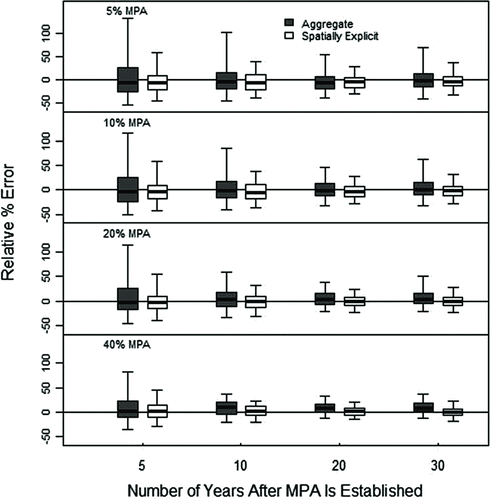Figures & data
TABLE 1 Definitions of the symbols used in data-generating and assessment models (MPA = marine protected area).
FIGURE 1 Pattern of annual fishing mortality (F) in the fished region over time for scenarios in which (A) the intrinsic rate of increase (r) equals 0.2 and F was reduced to the level that supports maximum sustainable yield (FMSY ) after implementation of the marine protected area (MPA), (B) r equals 0.4 and F was reduced to FMSY after MPA implementation, and (C) r equals 0.2 and fishing effort originally occurring in the MPA region was redistributed to the non-MPA region after MPA implementation. In the FMSY scenarios, the fishing effort applies to all MPA sizes (MPA = 5–40% of the total stock area). After the first 20 years, F in the MPA was zero.
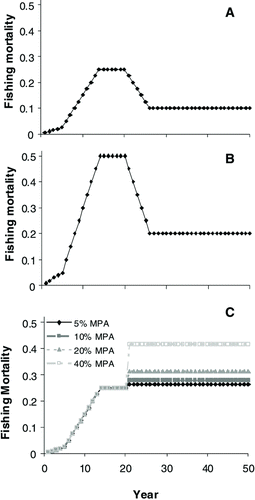
FIGURE 2 Biomass (units) in the marine protected area (MPA) region (black shading) and non-MPA region (gray shading) for each scenario defined by MPA size (MPA = 5–40% of the total stock area), migration rate (z), intrinsic rate of increase (r), and fishing mortality (F) pattern (F patterns are defined in ).
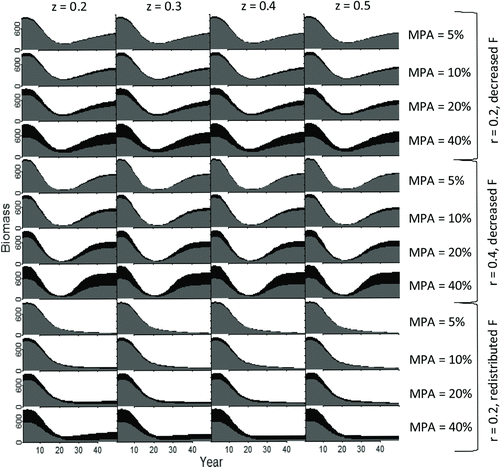
TABLE 2 Median of the absolute value of relative error (MARE) and median of the relative error (MRE) for each assessment model (i.e., spatially explicit surplus production model [SPM], spatially aggregated SPM, and assessments without survey data from the marine protected area [MPA]) under each scenario defined by migration rate (z), MPA size (percentage of the total stock area), observation error, intrinsic rate of increase (r), and fishing effort scenario (decreased or redistributed effort). For each scenario, the MARE and MRE closest to zero are italicized; the MARE and MRE with the largest absolute values are in bold.
FIGURE 3 Median absolute value of relative error (MARE) of estimated biomass in simulation year 50 for the spatially explicit surplus production model (Explicit), the spatially aggregated model (Aggregate), and the model in which no survey data were available from the marine protected area (MPA; No Survey) under scenarios with a low or high observation error (s = 0.2 or 1.0), a low or high intrinsic rate of increase (r = 0.2 or 0.4), and a pattern of decreased or redistributed fishing effort. Migration rate is 0.3 for all scenarios shown; MPA size is 5–40% of the total stock area.
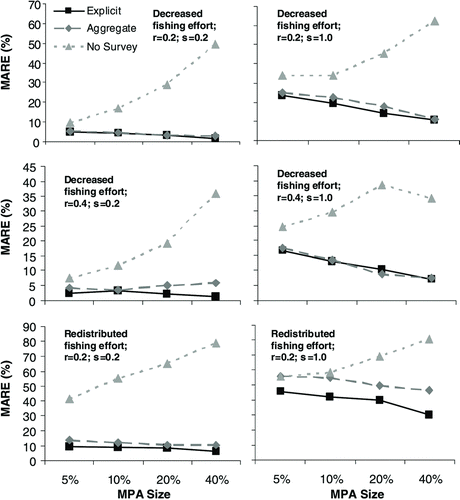
FIGURE 4 Median absolute value of relative error (MARE) of the parameter estimates from the spatially explicit surplus production model (Explicit), the spatially aggregated model (Aggregate), and the model in which no survey data were available from the marine protected area (MPA; No Survey) under scenarios with low observation error (s = 0.2), an intrinsic rate of increase (r) equal to 0.2, decreased fishing effort, and a migration rate equal to 0.3. The MPA size is 5–40% of the total stock area.

FIGURE 5 Box plots of the relative percent error in total biomass from scenarios of decreased fishing effort, an intrinsic rate of increase equal to 0.2, a migration rate of 0.3, and low observation error (s = 0.2) for both spatially explicit and spatially aggregated assessment models through time (MPA = marine protected area; MPA size = 5–40% of the total stock area). The dark line within each box is the median, ends of the box represent the interquartile range, and ends of whiskers indicate the 2.5th and 97.5th percentiles.
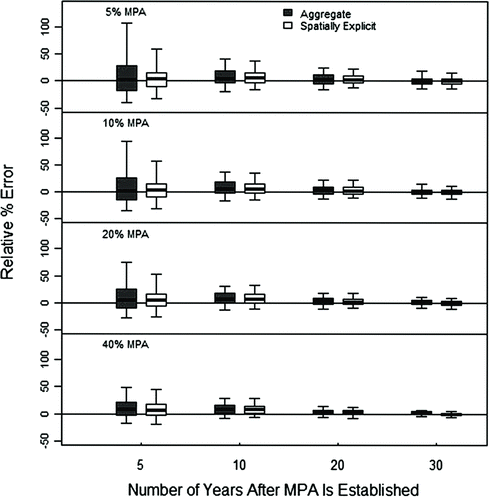
FIGURE 6 Box plots showing the relative percent error in total biomass from scenarios of redistributed fishing effort, an intrinsic rate of increase equal to 0.2, a migration rate of 0.3, and low observation error (s = 0.2) for both spatially explicit and spatially aggregated surplus production models through time (MPA = marine protected area; MPA size = 5–40% of the total stock area). Box plot elements are defined in .
